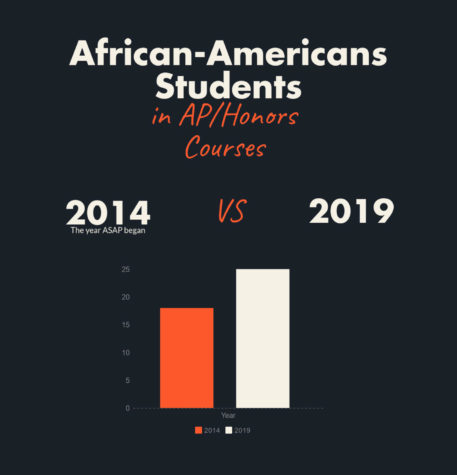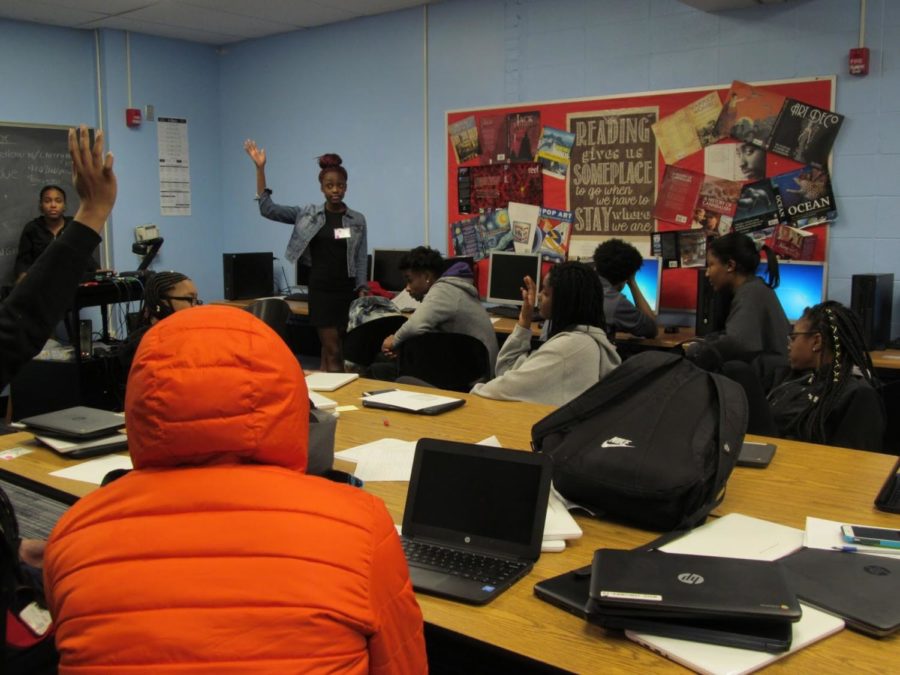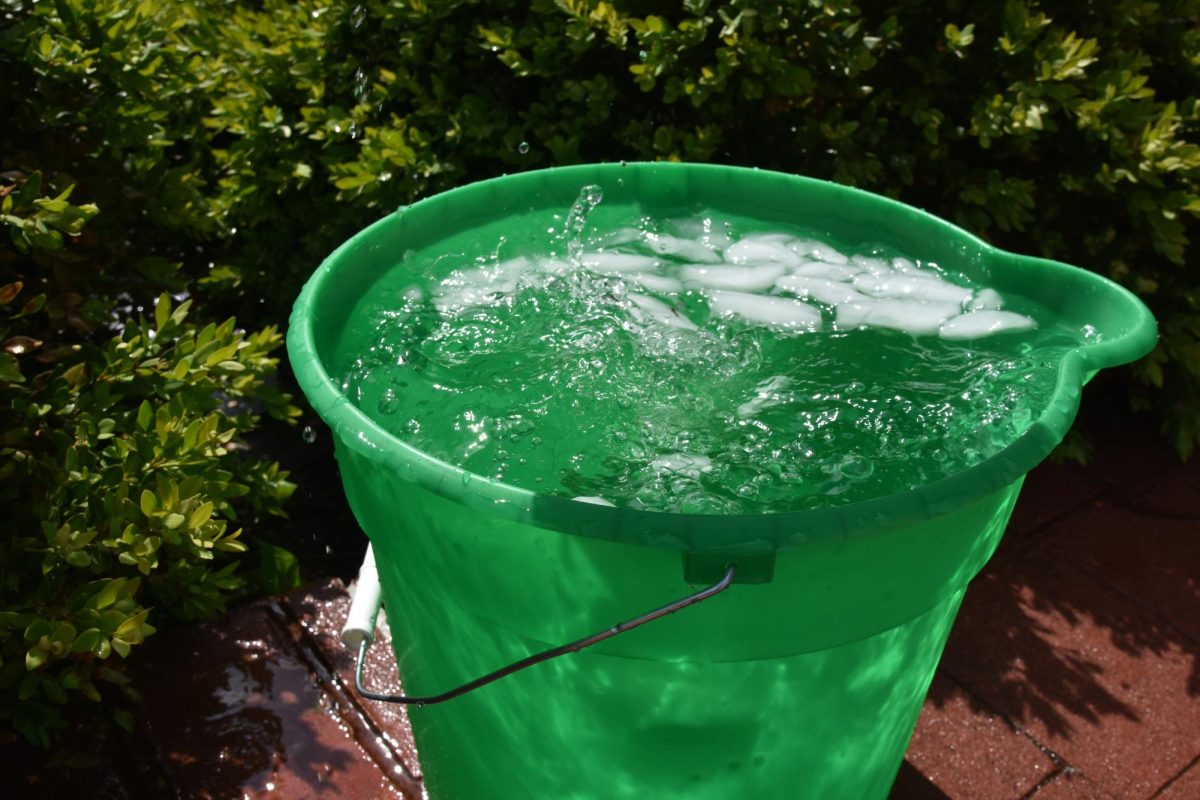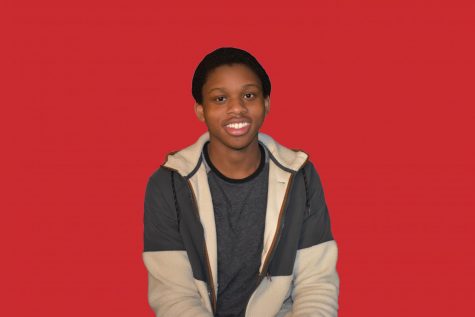Pairs of eyes peer into sponsor Carly Roach’s gaze as she explains why all African-American students in the school are in this room. Why have they been singled out?
“The very first meeting we had, you could feel there was a lot of distrust in the room. [So] we talked about the elephant in the room which was: ‘why is this room only made up of black students?’ then we talked about why it was important for students of similar color, background [and] experiences to get together to talk about how we can make progress,” Roach said. “For a while, we had to learn ways to support students without making them feel grouped. Students didn’t even necessarily want to get free passes during class. [But] over time, our group became closer, we formed relationships and we learned how to trust each other. Now it’s more of a source of pride because it’s a group that trust each other and helps each other reach their potential.”
Initially, the club was meant for African-American students who were enrolled in honors or advanced placement (AP) courses, and was a subcategory created under Parkway School District for their organization, Diversity in Action (DIA). Later, ASAP expanded membership to all interested African-American students in the school.
“The goal was originally to make sure that all minorities have equal opportunity and the label was for any black or African-American student who was in an AP or honors class,” sponsor Carly Roach said. “Northeast Middle School Principal Jen Sebold and I were on the DIA committee and we decided to make it a group so we could make sure students felt like their voices were being heard and that they felt safe in their classrooms. They give us feedback and let us know what our teachers, staff and principals need to change.”
One issue that Roach hoped to tackle was the disproportionately low amount of African-American students in AP and honors classes.
“Originally, we got into the club because we felt that we didn’t have enough students of color in AP or honors classes. When we first started, there was a total of 18 [students]. We also looked at if students of color make up 10 percent of our school’s population,” Roach said. “We reasoned that they should make up of about 10 percent of our AP or honors classes. It was less than five percent and so that’s where we thought: ‘what does that feel like to be the only student of color in a class?’”

Click to enlarge.
Not only were numbers low in advanced courses, but African-American students also saw lower numbers in attendance and higher numbers in suspensions.
“We also looked at other numbers such as attendance and discipline,” Roach said. “We identified that those were our problems and not our students’ problems. So [we asked ourselves] what should we be doing to help these numbers get better?”
Roach believes that it may be self-stereotyping that hinders some students academic performance.
“One theory is that people are biased about themselves and lower their expectations because they feel like that is what is expected of them. It’s also possible that they don’t necessarily see their peers at their same level,” Roach said.
According to president Kyra Clerk, meetings give students a chance to be expressive about how they feel in their classrooms.
“It gives us a place to feel comfortable and be able to express what it’s like to be an African-American student in a predominantly white classroom and school,” Clerk said. “It [also] gives us a chance to talk about our problems and be there for each other.”
Bethany believes that meetings are valuable time for teaching prominent lessons.
“We have taught them how to look out for one another [to keep] us accountable for our actions,” sponsor Melvin Bethany said. “I think they have done an awesome job of holding one another accountable, even down to the ‘n’ word and things of that nature—they have the dialogues and [are] able to talk about those things.”
Last January, students participated in a program called ‘Restorative Circles’ to get students more engaged and vocal in an uncomfortable setting.
“We wanted students to learn that you can and should have those uncomfortable conversations when certain things happen within our society. They may affect people emotionally or it may even affect them physically, but they are able to bring together a group of people of all kinds and have a conversation,” Bethany said. “[Then] we’re all able to walk out of there feeling some type of comfort. They’re basically restoring one another.”
Similarly, Clerk discovered how to keep oneself composed in an unfamiliar environment.
“Basically, we learned to be more vulnerable and not be so quick to put up a front,” Clerk said. “You have to be able to put yourself in someone else’s shoes, to understand as opposed to just knowing something and you have to be able to explain yourself and your feelings, but you should also feel comfortable doing it.”
Students are also expected to reach a certain standard by being involved in the club.
“I think that our group itself tries to set standards and high expectations in terms of maintaining solid grades to be able to attend and maintaining good citizenship with peer relationships,” Roach said. “I’m hopeful that the [graduation] cords will encourage students to take more rigorous classes and maintain high GPAs. Then we also sometimes will have study groups for students to meet together and help each other.”
Additionally, Bethany believes that ASAP has the ability to instill the qualities that they hope students can gain from the meetings.
“It may seem like ASAP is a separation but it’s really not. We’re just trying to give our kids the opportunity to see beyond what they see at home or in their community,” Bethany said. “When they come here, they have a sense of peace, comfort and they are able to say, ‘hey, I want to take what I learned at school put it back into my community.’ That way, they have learned how we can be better citizens, people and leaders in the African-American community.”





![Smiling in a sea of Longhorns, Fox 2 reporter Ty Hawkins joins junior Darren Young during the morning Oct. 3 pep rally. The last time West was featured in this segment was 2011. “[I hope people see this and think] if you come to [Parkway] West, you will have the time of your life because there are so many fun activities to do that make it feel like you belong here. I was surprised so many people attended, but it was a lot of fun,” Young said.](https://pwestpathfinder.com/wp-content/uploads/2025/10/Edited2-1200x798.jpg)
![West High seniors and families listen as a representative of The Scholarship Foundation of St. Louis, Teresa Steinkamp, leads a Free Application for Federal Student Aid (FAFSA) workshop. This session, held in the library, provided guidance on financial aid, scholarships and student loan options. “This event is very beneficial for any seniors who are applying to or considering applying to colleges after high school [because] the cost of college is on the rise for seniors and parents,” college and career counselor Chris Lorenz said.](https://pwestpathfinder.com/wp-content/uploads/2025/09/DSC_4478-1200x778.jpg)
![Senior Kamori Berry walks across the field during halftime at the Homecoming football game on Sept. 12. During the pep assembly earlier that day, she was pronounced Homecoming Queen. “I thought it was nice that the crowd [started] cheering right away. I know [my friends] were really excited for me, and my family was happy because typically non-white people don't win,” Berry said.](https://pwestpathfinder.com/wp-content/uploads/2025/09/DSC7046-Enhanced-NR-1200x798.jpg)



![Pitching the ball on Apr. 14, senior Henry Wild and his team play against Belleville East. Wild was named scholar athlete of the year by St. Louis Post-Dispatch after maintaining a high cumulative GPA and staying involved with athletics for all of high school. “It’s an amazing honor. I feel very blessed to have the opportunity to represent my school [and] what [it] stands for,” Wild said.](https://pwestpathfinder.com/wp-content/uploads/2025/05/unnamed-6-1200x714.jpg)
![The Glory of Missouri award recipients stand with their certificates after finding out which virtue they were chosen to represent. When discovering their virtues, some recipients were met with contented confirmation, while others, complete surprise. “I was not at all surprised to get Truth. I discussed that with some of the other people who were getting the awards as well, and that came up as something I might get. Being in journalism, [Fellowship of Christian Athletes and] Speech and Debate, there's a culture of really caring about truth as a principle that I've tried to contribute to as well. I was very glad; [Truth] was a great one to get,” senior Will Gonsior said.](https://pwestpathfinder.com/wp-content/uploads/2025/04/Group-Glory-of-Missouri.jpg)

